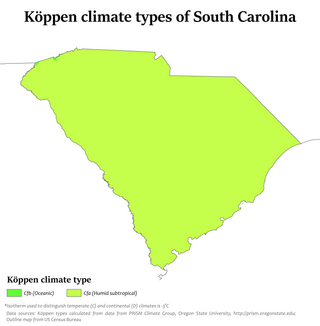
Climate change in Alabama encompasses the effects of climate change, attributed to man-made increases in atmospheric carbon dioxide, in the U.S. state of Alabama.

In contrast to other parts of the United States, Arkansas has not seen a significant increase in temperature over the last 50–100 years. In fact, some parts of the state have cooled. However, the state does receive more annual rainfall and more frequent downpours than other states. Over the next few decades, Arkansas is expected to warm, experiencing an increased severity of flooding and droughts. It is also expected to suffer more storm damage, reduced agricultural yields, and harm to livestock. Arkansas might also have to contend with a heightened risk of heat-related illnesses. In addition, there has been an increase in the number of tornadoes observed in the central United States, including Arkansas.

Climate change in Connecticut encompasses the effects of climate change, attributed to man-made increases in atmospheric carbon dioxide, in the U.S. state of Connecticut.

Climate change in Delaware encompasses the effects of climate change, attributed to man-made increases in atmospheric carbon dioxide, in the U.S. state of Delaware.

Climate change in Georgia encompasses the effects of climate change, attributed to man-made increases in atmospheric carbon dioxide, in the U.S. state of Georgia.
Climate change in Guam encompasses the effects of climate change, attributed to man-made increases in atmospheric carbon dioxide, in the U.S. territory of Guam.

Climate change in Indiana encompasses the effects of climate change, attributed to man-made increases in atmospheric carbon dioxide, in the U.S. state of Indiana.

Climate change in Iowa encompasses the effects of climate change, attributed to man-made increases in atmospheric carbon dioxide, in the U.S. state of Iowa.

Climate change in Kentucky encompasses the effects of climate change, attributed to man-made increases in atmospheric carbon dioxide, in the U.S. state of Kentucky.

Climate change in Louisiana encompasses the effects of climate change, attributed to man-made increases in atmospheric carbon dioxide, in the U.S. state of Louisiana.

Climate change in Michigan encompasses the effects of climate change, attributed to man-made increases in atmospheric greenhouse gases, in the U.S. state of Michigan.

Climate change in Minnesota encompasses the effects of climate change, attributed to human-caused increases in atmospheric carbon dioxide, in the U.S. state of Minnesota.

Climate change in Missouri encompasses the effects of climate change, attributed to man-made increases in atmospheric carbon dioxide, in the U.S. state of Missouri.

Climate change in the United States Virgin Islands encompasses the effects of climate change, attributed to man-made increases in atmospheric carbon dioxide, in the U.S. territory of the United States Virgin Islands. The United States Environmental Protection Agency (EPA) has noted a variety of expected consequences of this phenomenon.

Climate change in Rhode Island encompasses the effects of climate change, attributed to man-made increases in atmospheric carbon dioxide, in the U.S. state of Rhode Island.

Climate change in South Carolina encompasses the effects of climate change, attributed to man-made increases in atmospheric carbon dioxide, in the U.S. state of South Carolina.

Climate change in Tennessee encompasses the effects of climate change, attributed to man-made increases in atmospheric carbon dioxide, in the U.S. state of Tennessee.

Climate change in Virginia encompasses the effects of climate change, attributed to man-made increases in atmospheric carbon dioxide, in the U.S. state of Virginia.

Climate change in South Dakota encompasses the effects of climate change, attributed to man-made increases in atmospheric carbon dioxide, in the U.S. state of South Dakota.

Climate change in Pennsylvania encompasses the effects of climate change, attributed to man-made increases in atmospheric carbon dioxide, in the U.S. state of Pennsylvania.

























